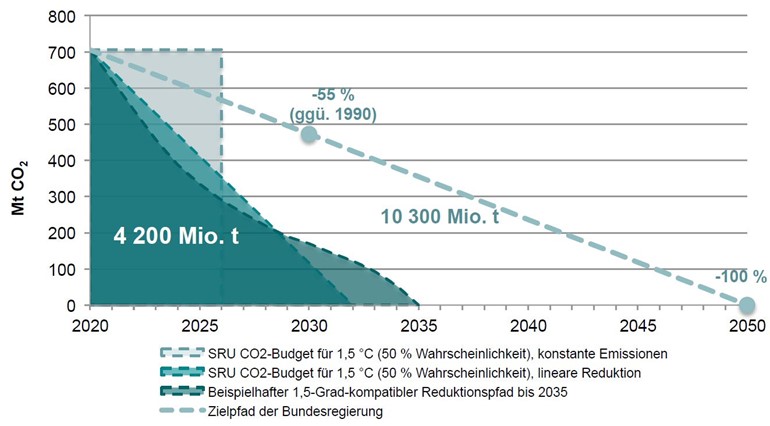Why 2030?
In the Paris Climate Agreement, the states have committed themselves to keeping global warming below 2 degrees, but preferably below 1.5 degrees. This preserves the chance of at least preventing the worst consequences of climate change. The extent of global warming depends largely on the total amount of CO2 emissions put into the atmosphere since pre-industrial times. Therefore, current climate models yield a residual amount (budget) of CO2 that may still be emitted if the 1.5-degree target is to be achieved with at least a 50% probability. In its 2018 special report [1], the United Nations Intergovernmental Panel on Climate Change (IPCC) puts this global budget at 580 Gt (billion tonnes) of CO2. If this budget is distributed evenly among all people, this results in a proportional budget of 4.2 Gt [2] for Germany from 2020. If emissions remain constant (0.71 Gt in 2019), this budget would be used up by the end of 2025 [3].
Of course, we in Göttingen must also do our part to at least not exceed the CO2 budget. So how quickly do we have to reduce CO2 emissions and achieve climate neutrality? This graphic [4] provides some information on this:
The shaded areas correspond to the residual budget of 4.2 Gt for Germany. It is immediately apparent that emissions must be drastically reduced as quickly as possible in order to comply with the residual budget. The path to climate neutrality in 2050, as planned by the federal government and also the city of Göttingen [5], would exceed the budget by a factor of 2.5 (light green, thick dashed line). On the other hand, the budget can just be met if we save 10% of 2020 emissions every year from now on, so that we arrive at zero emissions by the end of 2030 (medium-green straight line). Alternatively, we can reduce faster in the next few years to create a budget cushion for the period from 2029 and reach zero emissions in 2035 (dark green curve). This is also appropriate for Germany as a whole, since there are sectors, e.g. in industry, that can probably only become climate-neutral by 2035.
What does that mean for Göttingen? We don’t have steel and cement plants, an airport, etc.: we can and must already become climate neutral by 2030, also to contribute to the budget cushion for Germany. If we were to aim for climate neutrality only from 2035 (or later), then in order to meet the budget we would have to reduce emissions much faster in the next few years than we we would have to for climate neutrality in 2030 – and the measures have to start first and progress is slower rather than faster.
For this reason, the goal for Göttingen must be: climate neutrality 2030!
[3] In the 2020 evaluation report on the City of Göttingen’s Master Plan, the 1.5 degree target is abandoned and the approx. 40% higher CO2 budget for a probability of 67% for 1.75 degrees of global warming is set. Yet even this budget would be exceeded by a factor of two by 2050 if the current trend of CO2 emissions were to be maintained, and the city would be far from achieving climate neutrality.
[4] Wuppertal Institut (2020). CO2-neutral bis 2035: Eckpunkte eines deutschen Beitrags zur Einhaltung der 1,5-°C-Grenze.
https://fridaysforfuture.de/studie/
[5] https://www.goettingen.de/pics/medien/1_1510593601/Masterplan_100___Klimaschutz_Goettingen.pdf

